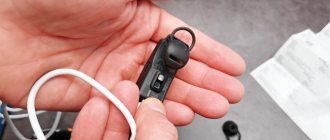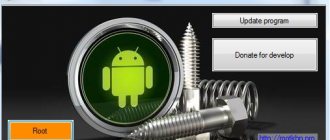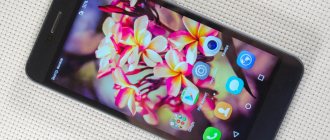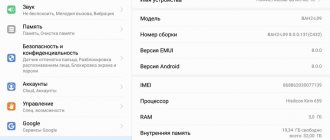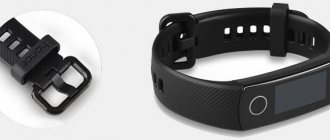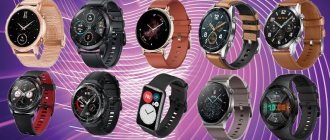Tablets are no longer as popular as they used to be, and this is primarily due to the fact that the diagonals of smartphone displays are constantly increasing, and users simply no longer need to use several devices at once. If budget models are still actively produced, including by little-known brands, then you can only find something decent in terms of hardware and functionality among the products of Huawei, Samsung and Apple, and sometimes something interesting appears in Lenovo’s portfolio.
We will get acquainted with one of these tablets. The review will look at the Huawei MatePad 10.4 model, which has almost all smartphone functions - the device has versions both without the ability to connect SIM cards and with LTE support, and it was the latter, more expensive version that came to us for testing.
Design and controls
Prev.Next- Dimensions : 245.2 x 154.96 x 7.35 mm
- Weight : 446 grams
- Body colours: gray
- Case material: plastic
In terms of its design, the tablet hardly stands out from its analogues - the plastic body of the device is easy to use due to its well-distributed weight (and it doesn’t matter that the tablet weighs almost 450 grams) and rounded sides, thanks to which the corners do not dig into the palms. The back surface is matte, and it will be difficult to notice fingerprints on it, and the tablet does not slip in your hands.
On the top edge, in addition to the volume rocker, there are four microphones, which should provide an excellent level of noise reduction , at least indoors. On the street, you can sometimes hear wind noise when recording video, but the tablet is positioned primarily as the best option for home use and distance learning.
There are also four speakers - two on each side of the device . The declared sound is from Harman/Hardon, which is distinguished not only by high volume and good stereo effect, but also by high quality. This is the case when speakers can really replace small portable speakers - the sound is excellent both in games and when listening to music.
On the right side frame, if you look closely, you can see a light sensor that regulates not only the backlight brightness level depending on the external lighting, but also the color temperature . I note that this setting can be completely disabled if necessary.
Prev.Next
Just to the right of the camera there is a fairly bright LED event indicator , which lights up in red, white and green depending on the charge level.
For charging, a modern Type-C port is used , to which, in the absence of a 3.5 mm jack, wired headphones can also be connected. The package already includes an adapter from Type-C to 3.5 mm.
The card tray allows you to connect only one nano SIM card , but you can additionally install a microSD memory card, which will be important for some users, given that 64 GB of built-in storage is not always enough in modern realities.
The unit with the camera and flash on the back of the tablet protrudes , so without using a case, the risk of scratching the module increases.
About the Huawei MatePad 10.4 display
Anti-glare properties
Illumination Uniformity
Colorful temperature
Color gamut
Prev.Next
- Matrix : 10.4 inches. IPS
- Resolution : 2000 x 1200 pixels (224 ppi)
- Maximum white brightness : 528 nits
- Minimum white brightness: 2.6 nits
- Contrast: 1300:1
- Color temperature: 7000-8500K
- Screen refresh rate: 60Hz
- Multi-touch: 10 touches
- Oleophobic coating: yes
The tablet's display is typical for this class of devices - it is an IPS matrix with FullHD+ resolution, excellent viewing angles and a high-quality oleophobic coating . The maximum measured backlight level was 528 nits, which is even higher than the official indicators (470 nits), and this indicator is enough for comfortable use of the screen, including in bright sunlight, given that the screen does not glare much.
I was also pleased with the minimum brightness - it is low enough to use the screen in complete darkness . There is no flickering of the backlight at low brightness, so there is no doubt that the eyes will be as comfortable as possible in all cases.
The backlight uniformity is not bad - about 89%, although the brightness drop in the lower right corner of the display (in horizontal orientation) is confusing, but it was not possible to notice any problems with the naked eye.
The screen's color gamut is close to sRGB, and overall the colors displayed are pleasing and realistic. The only thing is that the color temperature is shifted towards blue, and in the tablet settings I was not able to set the optimal value to 6500K - at best it turns out to be about 7000K, but this is unlikely to be a significant disadvantage for anyone.
Screen
The new product is equipped with a 10.4-inch display made using IPS technology. The matrix resolution is 2,000 × 1,200 pixels, which provides a pixel density of 224 ppi - a completely acceptable result by tablet standards. The picture is clear, the small font is easy to read.
Photo: Artyom Bagdasarov / Lifehacker
The contrast level is sufficient so that the black color does not look faded. When viewed from an angle, the image fades a little, but this does not interfere with the use of the device.
Color reproduction is calm, and some users will not like this. Unfortunately, there is no choice of ready-made color profiles in the settings, but you can adjust the picture using an RGB circle.
The brightness reserve for IPS is excellent, readability in the sun does not drop much. There is also a “Natural Tone” mode that adapts color rendering to lighting conditions, and a blue filter that reduces eye strain.
Performance and operating system Huawei MatePad 10.4
Prev.Next- Processor : 8-core HiSilicon Kirin 810 (2 cores Cortex-A76 2270 MHz, 6 cores Cortex-A55 1880 MHz)
- Graphics : Mali-G52, 820 MHz
- RAM: 4 GB
- User memory: 64 GB
- Operating system: Android 10 with EMUI 10.1 shell
- Sensors : accelerometer, light, magnetometer, Hall sensor
The tablet has relatively powerful hardware, and competitors for the same price do not have anything similar. HiSilicon Kirin 810 easily scores about 300,000 points in Antutu when the performance mode is turned on in the battery settings, and this power is enough to solve any or almost any tasks.
Various applications show that the tablet is not prone to loss of performance under long-term loads , but it was even more surprising to see drops of up to 15 FPS in the game World of Tanks on high graphics settings. Perhaps this is due to poor optimization of the game for the tablet hardware. As it turned out, you can play comfortably without drawdowns at low settings, or there is an option with less sacrifice, which is to turn off the display of shadows - they are the main problem with drawdowns. But PUBG, like many other games, always works great on high graphics, and the only thing is that Fortnite is not officially supported. There is no significant heating of the case when playing games for a long time.
Prev.Next
The operating system is represented by the new tenth Android with the proprietary EMUI shell, although without support for Google services, which at the time of writing the review could not even be installed unofficially (with the exception of Youtube Vansed software, but the popular video hosting service can also be used through a browser). To download applications and games, the manufacturer suggests using the official AppGallery store, or third-party solutions, such as APKPure software, in which the number of applications is significantly higher than in the pre-installed Huawei version.
The operating system was initially designed for gesture control and is well optimized for the tablet screen, and firmware updates are also released periodically, so there should be no complaints about the operation of the OS.
Of the sensors, I personally was missing only a gyroscope, which would be useful for watching 360-degree videos.
We have already done a detailed review of the Huawei MatePad Pro, a tablet with a 10.8-inch screen that has excellent capabilities for designers and artists and can significantly replace a laptop. The Huawei MatePad coming out now is a simplified version of the MatePad Pro, which is also capable of pleasing designers, but to a slightly lesser extent claims to be a universal working tool to replace a laptop.
| Huawei MatePad | Huawei MatePad Pro | Huawei MediaPad M6 10.8 | |
| Display | 10.4 inches, IPS, 2000 × 1200 pixels (5:3), 224 ppi, capacitive multi-touch | 10.8 inches, IPS, 2560 × 1600 pixels (16:10), 280 ppi, capacitive multi-touch | 10.8 inches, IPS, 2560 × 1600 pixels (16:10), 280 ppi, capacitive multi-touch |
| Protective glass | No data | No data | No data |
| CPU | HiSilicon Kirin 810: eight cores (2 × Cortex-A76, 2.27 GHz + 6 × Cortex-A55, 1.88 GHz) | HiSilicon Kirin 990: eight cores (2 × Cortex-A76, 2.86 GHz + 2 × Cortex-A76, 2.09 GHz + 4 × Cortex-A55, 1.86 GHz) | HiSilicon Kirin 980: eight cores (2 × Cortex-A76, 2.60 GHz + 2 × Cortex-A76, 1.92 GHz + 4 × Cortex-A55, 1.8 GHz) |
| Graphics controller | Mali-G52 MP6 | Mali-G76 MP16 | Mali-G76 MP10 |
| RAM | 4 GB | 6/8 GB | 4 GB |
| Flash memory | 64 GB | 128/256/512 GB | 64/128 GB |
| Memory card support | Yes (microSD up to 512 GB) | Yes (NV up to 256 GB) | Yes (microSD up to 512 GB) |
| Connectors | USB Type-C | USB Type-C | USB Type-C |
| SIM cards | No | One nano-SIM | One nano-SIM |
| Cellular connection 2G | GSM 850/900/1800/1900 MHz | GSM 850/900/1800/1900 MHz | GSM 850/900/1800/1900 MHz |
| Cellular 3G | HSDPA 800/850/900/1900/2100 MHz | HSDPA 800/850/900/1700/1900/2100 MHz | HSDPA 800/850/900/1700/1900/2100 MHz |
| Cellular 4G | LTE, bands 1, 2, 3, 5, 7, 8, 18, 19, 20, 26, 28, 38, 40, 41 | LTE Cat. 13 (up to 400/75 Mbit/s), bands 1, 3, 4, 5, 8, 19, 34, 38, 39, 40, 41 | LTE Cat. 13 (up to 400/75 Mbit/s), bands 1, 3, 4, 5, 8, 19, 34, 38, 39, 40, 41 |
| WiFi | 802.11a/b/g/n/ac | 802.11a/b/g/n/ac | 802.11a/b/g/n/ac |
| Bluetooth | 5.1 | 5.0 | 5.0 |
| NFC | No | Eat | Eat |
| Navigation | GPS (dual band), A-GPS, GLONASS, BeiDou | GPS (dual band), A-GPS, GLONASS, BeiDou, Galileo, QZSS | GPS (dual band), A-GPS, GLONASS, BeiDou |
| Sensors | Illumination, proximity, accelerometer/gyroscope, magnetometer (digital compass) | Illumination, proximity, accelerometer/gyroscope, magnetometer (digital compass) | Illumination, proximity, accelerometer/gyroscope, magnetometer (digital compass) |
| Fingerprint's scanner | No | No | Yes, in front |
| Main camera | 8 MP ƒ/2.0, autofocus, LED flash | 13 MP ƒ/1.8, phase detection autofocus, LED flash | 13 MP ƒ/1.8, phase detection autofocus, LED flash |
| Front-camera | 8 MP, ƒ/2.2, fixed focus | 16 MP, ƒ/2.0, fixed focus | 16 MP, ƒ/2.0, fixed focus |
| Nutrition | Non-removable battery: 27.55 Wh (7250 mAh, 3.8 V) | Non-removable battery: 27.55 Wh (7250 mAh, 3.8 V) | Non-removable battery: 28.5 Wh (7500 mAh, 3.8 V) |
| Size | 245.2 × 155 × 7.4 mm | 246 × 159 × 7.2 mm | 257 × 170 × 7.2 mm |
| Weight | 450 grams | 460 grams | 498 grams |
| Housing protection | No | No | No |
| operating system | Android 10.0 + EMUI 10 + HMS (without Google services) | Android 10.0 + EMUI 10 + HMS (without Google services) | Android 9.0 Pie + EMUI 9.1 |
| Current price | 21,990 rubles | 44,990 rubles | 24,990 rubles |
It doesn’t take long to get confused in the intricacies of the Huawei tablet lineup, despite the small number of models: there is a clear flagship, the most powerful and “professional” MatePad Pro, there is a multimedia and family MediaPad M6, and there are last year’s MediaPad M5 and MediaPad M5 lite. The new member of the family, “simply” MatePad, occupies its own special niche - it is half the price of the MatePad Pro, but it is also cheaper and a little simpler in a number of characteristics than the MediaPad M6. It is positioned as a tablet for work and entertainment (in that order), but for those who do not need the maximum in all characteristics.
Design, display, sound
Externally, Huawei MatePad logically takes the basis of the Pro version: a matte metal back cover and an oblong camera block - straight from there. But the front part is greatly simplified - the front camera here does not intrude into the surface of the screen, but is integrated “in the old fashioned way” into the edge of the screen, which is not small at all. The edge thickness is 7.9 mm, the edges of the tablet are thinner. But nothing interferes with the image on the screen - for a tablet, in my opinion, this is more important than compactness.
Dimensions of Huawei MatePad – 245.2 × 155 × 7.4 mm. About the same as the MatePad Pro, but a little narrower and lower, and at the same time skinnier. Still, the screen diagonal is smaller here, but the battery is the same. The body is made of high quality, monolithic. There is only one color option, “midnight grey”.
The edges are plastic, rounded, they contain both physical keys (power button, located on the top/left side and volume control, on the right/top, depending on the vertical or horizontal grip), a USB Type-C port, speakers and microphones. There is, alas, no mini-jack - Huawei was not generous with it, unlike the MediaPad model; in that case the multimedia focus of the tablet was emphasized, in this case there is nothing to emphasize.
But it’s not without reason that speakers and microphones are indicated in the plural – there are four of them, just like in the MatePad Pro. You can reasonably count on high-quality sound and excellent transmission of your voice during a video call; the microphones are also equipped with a good noise reduction system.
The display here is simpler than in the MediPad M6 and MatePad Pro: it is smaller, 10.4 inches versus 10.8, and the resolution is lower, 2000 × 1200 pixels. The pixel density is 227 ppi, which can be called average for a tablet. However, this is still more than Full HD - you can notice some pixelation in the fonts, but overall the picture is smooth and clear. Interestingly, the display format has also changed compared to its predecessors - 5:3 instead of 16:10. But such minimal changes, of course, do not seriously affect the experience of working with the tablet.
It uses an IPS panel with good viewing angles and decent brightness - the stated level of 470 nits still does not allow you to count on HDR10 certification, but it means that you can use the tablet outdoors. Color rendition is high quality. There is a reading mode certified by TÜV Rheinland.
It is worth saying that there is no fingerprint sensor in the Huawei MatePad - you can rely solely on facial recognition using a lone front camera.
Accessories
In terms of support for the “body kit”, the MatePad is expected to completely follow the Pro version. They are, of course, not included in the kit, but you can separately purchase the Huawei Smart Magnetic Keyboard and the M-pencil stylus.
It is curious that the keyboard does not have a connector for connection and is simply attached using a magnet. For more convenient operation of the keyboard, there is a special interface mode - EMUI 10 imitates the Windows desktop with the bottom line of open applications. The stylus will not be given as a gift when purchased on the official website, as is the case with the MatePad Pro, but they will give a fifty percent discount on it (without a discount it costs 9,990 rubles). The stylus recognizes 4096 degrees of pressure, charges wirelessly and attaches to the tablet using a magnet.
Hardware, wireless communications, autonomy
The hardware platform used is HiSilicon Kirin 810, a mid-range system-on-chip that we saw, for example, on the recent Huawei P40 lite smartphone. It is made using a 7-nanometer process technology, the central processor contains eight cores (two Cortex-A76 with a maximum frequency of 2.27 GHz and 6 Cortex-A55 cores with a maximum frequency of 1.88 GHz). The Mali-G52 MP6 chip acts as a graphics accelerator. The platform’s performance is sufficient not only for all kinds of Internet, office and instant messenger tasks, but also for most games. In terms of power, the MatePad is inferior to both the Pro version (with Kirin 990) and the MediaPad M6 (with last year's flagship Kirin 980), but the overall level is quite decent.
You can count on design software or art programs to open quickly and work without problems - and there is a supply for several years to come. The tablet also received 4 GB of RAM and a 64 GB storage drive - the numbers are not large, but there is enough RAM for the needs of the tablet, and the permanent memory can be expanded using a microSD card (supported with a capacity of up to 512 GB). There is also a 6/128 GB version, but it is not supplied to Russia. It’s interesting that a completely unusual version came to us - with 3/32 GB of memory; something like this does not appear on the company’s official website at all.
Also, only the version with a SIM card slot is supplied to Russia, supporting 2G/3G/4G mobile networks - in all cases, the tablet demonstrates good connection speed and stability, and the list of supported LTE bands takes into account the peculiarities of the CIS space.
Other wireless modules: dual-band Wi-Fi (802.11a/b/g/n/ac), Bluetooth 5.1 (with support for high-quality data transfer profiles), navigation module with support for GPS (A-GPS), GLONASS, BeiDou. There is no NFC in Huawei MatePad.
Despite the smaller diagonal screen, the tablet has the same battery capacity as the MatePad Pro - 27.55 Wh (7250 mAh, 3.8 V). It allows you to count on approximately the same numbers: up to 12 hours when watching videos and up to 7 hours in game mode; actual figures will be lower, but not too significantly.
Camera
In Huawei MatePad, both the rear and front cameras are installed not just for show, but they do not shine with quality. These are fairly single basic modules of 8 megapixels each, with f/2.0 lenses for the rear camera and f/2.2 for the front one. Autofocus works on the rear, there is a flash, but neither flash nor autofocus is provided for the selfie camera.
The quality of shooting can be seen in the examples below - ordinary “tablet” quality, no surprises; Even during the day the picture is not very clear, the detail “spreads” a little, but at night the quality is quite low. The 2x zoom triggered by the camera app is digital, with a strong loss of detail.
The front camera has wider-angle optics and is quite suitable for performing its duties in Zoom, Skype and any other instant messenger for video conferencing. But due to the wide angle, the distortion of facial proportions slightly exceeds the boundaries. Example below.
Video recording is possible in Full HD resolution on both the rear and front cameras.
Software
Like all smartphones and tablets released in 2021 under the Huawei brand, the MatePad received the Google Android 10 operating system with the EMUI shell and without Google services. And if in the case of smartphones this shortage, even with all the efforts of Huawei, which is powerfully developing its ecosystem, looks critical, then for a tablet, to be honest, not particularly so. At least for the tablet as a multimedia device. Specific design software or, for example, Adobe products may not be in the AppGallery, but they can also be downloaded as apk files in the same APK Pure, for example. They will work without restrictions.
I will note several features of EMUI 10 for tablets: the Huawei Share system makes it very easy to “transfer” a smartphone to a tablet in the form of a virtual environment, the Multi-Window multi-window mode makes it possible to comfortably perform several tasks at the same time, and using the Huawei App Multiplier function you can perform various operations in the same application (open descriptions of two different products to quickly choose which one suits you, or read the text of a news article and simultaneously look at its photos).
Conclusion
The Huawei MatePad tablet is not so much weaker than the MatePad Pro as it is cheaper. It seems a very interesting choice for anyone who is thinking about a more compact and simple replacement for a laptop, at least in some situations: it is capable of interacting in specially designed environments with a comfortable keyboard and stylus, has a number of interesting software solutions, and at the same time has enough power to remain technically relevant for several more years.
Pre-order of Huawei MatePad started on June 5 - the tablet is available at a price of 21,990 rubles; When you pre-order, you will receive Huawei Freebuds 3 headphones as a gift, which is very generous - they themselves cost less than half the price. In addition, you can purchase a stylus with a 50% discount or choose a second free gift (there are several accessories to choose from).
Cameras in Huawei MatePad 10.4
Prev.Next
- Main module: 8 MP, f/2.0, autofocus, flash
- Front camera: 8 MP, f/2.2, without autofocus and flash
There is only one main camera, but we are dealing with a tablet, especially not the most expensive one , so the most important thing is that the device allows you to photograph documents and various inscriptions, with which there are no problems, thanks to the presence of autofocus. If there is enough lighting, then you can get relatively beautiful pictures in nature, as you can see by looking at the examples below. In poor lighting, a flash can save the situation.
Prev.NextVideo recording on both the main and front cameras can occur in HD or FullHD resolution, and exclusively at 30 FPS . I was pleased that automatic focusing works, meaning that in most cases the user no longer needs to press the screen while shooting.
The front camera, in my opinion, is needed exclusively for video communication, judging by the quality of the photos. However, there are modes for beautifying the face and there is a flash, the role of which is played by the screen.
Prev.Next
Camera
The new product received an 8-megapixel camera with autofocus. There is no need to talk about quality: the frames are dim, the detail is low. A similar result can be obtained with a cheap smartphone under 10 thousand rubles.
Photo: Artyom Bagdasarov / Lifehacker
But the 8 MP front camera is great for video calling, and it also takes satisfactory selfies.
Main camera
Main camera
Main camera
Selfie
Huawei MatePad 10.4 operating time
- Battery capacity: 7250 mAh
- Fast wired charging: supported
- Wireless charging: no
- Charger included: 18 W (9 V, 2 A)
A full battery charge lasts for quite a long time in various modes, and if you don’t get involved in heavy games, you will rarely have to charge the tablet . In HD video viewing mode in the MX player, the tablet worked for 15 hours 28 minutes at a brightness of 150 nits, which is quite enough for using the screen indoors. The PUBG game at the same brightness runs for just over 8 hours at high graphics settings, and the synthetic PC Mark test gave 14 hours already at a brightness of 200 nits.
In one hour, the tablet charges up to 41%, while a full charge takes 3 hours 30 minutes. The charging power does not exceed 13.6 W, that is, the capabilities of the included power supply are not used to the maximum, but anything more than 10 W can already be considered fast charging.
Unlocking methods in Huawei MatePad 10.4
- Fingerprint scanner: no
- Face recognition: yes
- Unlock via Bluetooth: yes (using a bracelet)
In the absence of a fingerprint scanner, the main unlocking method for most users should be facial identification . And this method works accurately - it takes about 1.2 seconds to unlock, and unlocking in the dark is also available due to the function of filling the screen with white. What’s nice is that the white background is first displayed at a low brightness and, as necessary, its level increases until the face is recognized.
Communication in Huawei MatePad 10.4
Prev.Next
- LTE bands: B1/B2/B3/B7/B8/B19/B20/B26/B28/B38/B40/B41
- 5G support: no
- eSIM support: no
- Wi-Fi: 2.4 + 5 GHz
- Bluetooth: version 5.1
- Navigation : GPS, GLONASS, Beidou, GALILEO
- USB-OTG: yes
- NFC: no
If we consider the LTE version of the tablet, then it is quite suitable as a dialer. You can both receive calls and make calls. True, without using wired or wireless headphones, only speakerphone will be available - two speakers on the left side work during calls. Given the lack of a proximity sensor, the screen will need to be turned off manually if necessary.
Typing and reading text messages are also available, as is, of course, fast 4G Internet . The tablet is also excellent as a navigator due to its support for all navigation systems, a bright screen and an electronic compass.
What to buy instead of the Huawei Matepad 10.4 tablet
At the time of writing the review, the Huawei Matepad 10.4 tablet, or rather its version with LTE support, was sold for 23,999 rubles, and for that kind of money it is difficult to find something with the same powerful hardware, support for 4G networks and the current version of Android.
There is, of course, a slightly more expensive Samsung Galaxy Tab S6 Lite , if not fundamentally the presence of LTE, but its processor is much weaker, and it also has fewer speakers and microphones, and there is no flash for the rear camera. But there is a stylus included, a gyroscope, a separate 3.5 mm jack, a metal case and support for Google services, which Huawei is deprived of due to sanctions.
Samsung Galaxy Tab S6 Lite
Fans of Apple and their operating system can also take a closer look at the Apple iPad 2021 32 GB , and I would highlight the presence of a gyroscope, a fingerprint scanner, a 3.5 mm jack, and, again, a metal case, while in other functions the tablet is inferior to the hero of the review , at least according to performance characteristics.
Apple iPad 2021 32 Gb
But what stands out the most is the Huawei MediaPad M6 (10 inches), which has almost all the advantages of the previously mentioned models, except perhaps the stylus and Google services - in my opinion, this is the best option for its price if LTE is not needed.
Huawei MediaPad M6
Why Huawei MediaPad X1 7?
Few people Huawei with a serious brand, but already this year it has reached third place in terms of its share of the mobile market, the leaders of which are Apple and Samsung. The Chinese are actively and confidently developing, beginning to squeeze out global manufacturers not only with the cheapness of their devices, but also with their technical capabilities. Yes, they actively use the design ideas of competitors, yes, there are still flaws and shortcomings, however, the pace of development is simply amazing. If we continue talking about Huawei, then just remember the flagship Ascend P6 (thickness only 6.18 mm) and the new Ascend P7 :
Huawei Ascend P7 awarded the prestigious EISA 2014-2015 award in the category "Best Smartphone for Consumers 2014-2015": 5-inch Full HD IPS display, HiSilicon Kirin 910T quad-core processor + Mali-450 MP GPU, 2 GB RAM, 16 GB flash memory, microSD slot, 8 MP front camera and 13 MP main camera, BT 4.0, Wi-Fi 802.11b/g/n, 3G, LTE, 2500 mAh battery, weight - 124 g, thickness - 6.5 mm
The company has also distinguished itself in the field of tablets, or tablet phones. In general, the MediaPad X1 7 ended up somewhere in the middle between a tablet and a tablet phone, no matter how strange it may sound. Possessing full telephone functionality, it is replete with an impressive 7-inch display. The same giant Xperia Z Ultra is equipped with a 6.4-inch screen, and in the “Chinese” it is even larger. At the same time, in terms of its dimensions ( 183.5 x 103.9 x 7.18 mm , 239 g ), this Huawei development is a record holder among 7-inch tablets and in design it is still closer to tablet phones. In fact, it's the smallest 7-inch tablet on the market that feels very large in your hand, but it's still a phone.
In addition, the gadget is equipped with very high-quality components and, in terms of the totality of its characteristics, it also turned out to be very, very good. Actually, all this was the reason for choosing this device, which I became interested in at the time of its announcement in March of this year.



